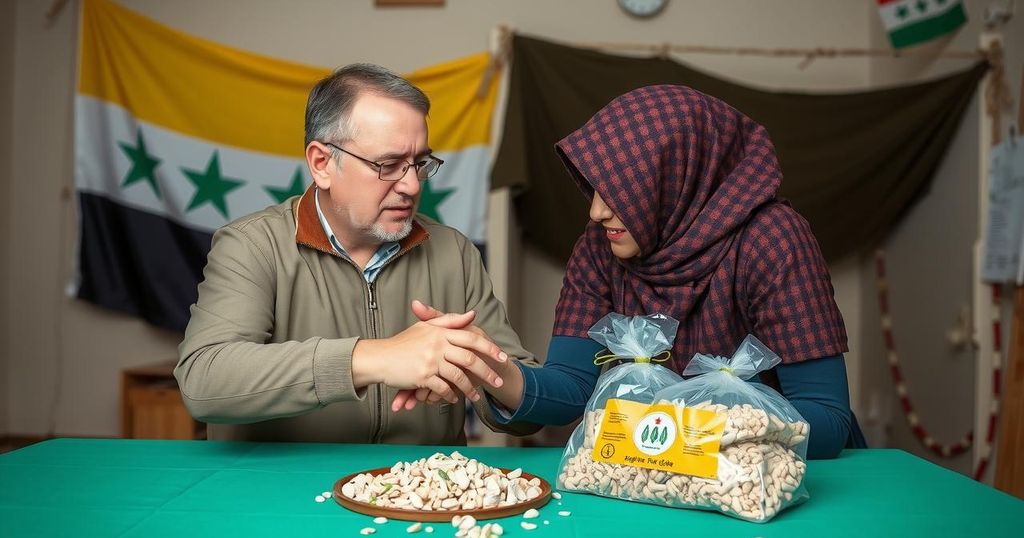World news
AHMED AL - SHARAA, AL -, ASA, ASIA, BASHAR AL - ASSAD, DIPLOMACY, EUROPE, EUROPE/ASIA, HAYAT TAHRIR AL - SHAM, INTERNATIONAL RELATIONS, REUTERS, RUSSIA, RUSSIA-UKRAINE WAR, RUSSIAN INVASION OF UKRAINE, SY, SYBIHA, SYRIA, UKRAINE, UNITED NATIONS WORLD FOOD PROGRAMME, US, WAR
Sofia Rodriguez
0 Comments
Syria Pursues Strategic Ties with Ukraine Amid Declining Russian Influence
Syria seeks to establish strategic partnerships with Ukraine, symbolizing a shift in diplomacy amidst decreasing Russian influence. Syria’s Foreign Minister proposed collaborations across various sectors, while Ukraine plans to increase food aid shipments to support the Syrian populace. The changing dynamics call into question the future of Russian military bases and relations in the region, as both countries navigate their new roles globally.
Syria’s Foreign Minister, Asaad Hassan al-Shibani, expressed aspirations for “strategic partnerships” with Ukraine during a meeting with Ukrainian official Andrii Sybiha in Damascus. This diplomatic overture reflects Ukraine’s desire to strengthen ties with the newly established Islamist leadership in Syria amidst declining Russian influence in the region. Comparatively, al-Shibani articulated a shared experience of suffering between Syria’s civil conflict and Ukraine’s ongoing conflict with Russia, stating that both nations have endured significant hardships over the past decade.
In response to these evolving relations, Ukraine announced its intention to send additional food aid to Syria, building upon the recent shipment of 500 metric tons of wheat flour. This initiative, part of Ukraine’s humanitarian “Grain from Ukraine” program, leverages the partnership with the United Nations World Food Programme. While Ukraine aims to reestablish its role as a grain supplier to the Middle East, Syria faces challenges following the suspension of Russian wheat supplies due to uncertainties surrounding its new government.
Furthermore, the shifting political landscape raises questions about the future of Russian military bases in Syria, which previously had strong strategic significance under Assad’s regime. Russian officials, including Foreign Minister Sergei Lavrov, indicated that negotiations would take place with Syria’s new leadership concerning the status of these bases. Despite the newly ascended Islamist group, Hayat Tahrir al-Sham, proclaiming that future relations with Russia should align with shared interests, the trajectory of Syrian-Russian relations remains uncertain due to lack of clarity and complex financial arrangements sufficient to circumvent international sanctions.
In sum, Syria is pivoting towards Ukraine amid fluctuating geopolitical dynamics, creating opportunities for humanitarian assistance and opening avenues for deeper bilateral cooperation.
The context of this evolving relationship stems from Syria’s prolonged civil conflict beginning in 2011, which saw the downfall of significant political alliances, particularly with Russia. The recent rise of the Islamist faction, Hayat Tahrir al-Sham, has further complicated Syria’s international relations, especially concerning its traditional dependency on Russian food imports. With significant changes in leadership, both Syria and Ukraine are navigating new partnerships, along with complications regarding international sanctions that affect trade and military cooperation. Ukraine is seeking to rebuild its alliances and address food insecurity in the region, especially as its agricultural capabilities regain focus post-conflict.
To conclude, Syria’s outreach to Ukraine signifies a strategic pivot in response to declining Russian influence and a desire for humanitarian cooperation. Ukraine’s commitment to increasing food aid reinforces its humanitarian efforts while fostering new alliances in the Middle East. The uncertain future of Russian military presence in Syria will likely shape the geopolitical landscape in the region, as both nations explore various avenues for cooperation amidst shared experiences of conflict and hardship.
Original Source: www.hindustantimes.com




Post Comment